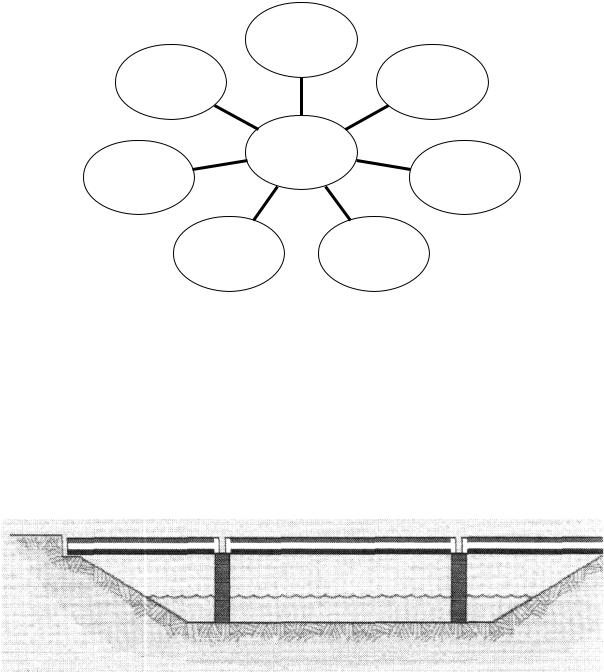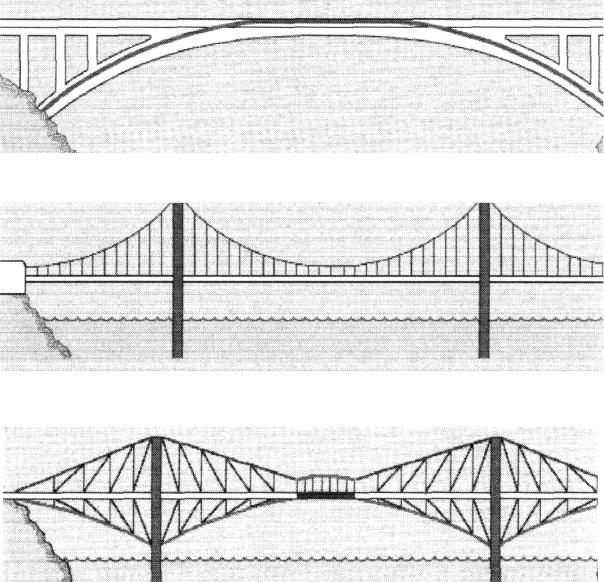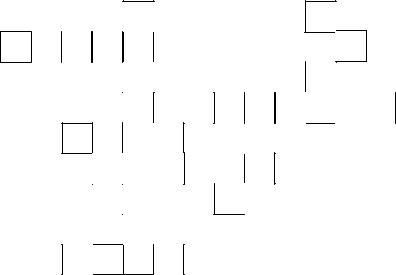
2376
.pdfIII. What verbal is used in the following sentences? What is its function in the sentence? Paraphrase the sentences using the Gerund instead of the Infinitive where it is possible.
1.Arterial railways and motorways have to overcome different natural obstacles.
2.Men have built constructional works to provide a passage through natural or artificial obstacles.
3.Constructional works are aimed to protect the permanent way against the adverse environment effects.
4.Constructional works are considered to be the most complicated ones.
5.If a barrier is a narrow stream or a temporary channel it is much cheaper to construct a culvert.
6.People build viaducts to improve communication.
IV. Retell the text using the word combinations below.
1. The title of the story I want to tell you is… 2. First of all … 3. Second I would like to say that… 4. As far as I understand… 5. In fact… 6. As far as I remember… 7. In conclusion I’d like…
Text 3
I. Listen and repeat: |
|
||
superstructure |
['sHpqstrAkCq] |
пролетное строение |
|
pier |
[pIq] |
опора |
|
abutment |
[q'bAtmqnt] |
устой |
|
footing |
['fVtIN] |
фундамент |
|
embankment |
[Im'bxNkmqnt] |
дамба, насыпь; набережная |
|
flood control dam |
[flAd kqn'trqVl |
струенаправляющая дамба |
|
groynes |
dxm] |
траверсы |
|
river-bed |
[grOInz] |
pycлo |
|
floodplain |
['rIvqbed] |
пойма |
|
bridge crossing |
['flAdpleIn] |
мостовой переход |
|
bridge bearing |
['brIG |
опорная часть |
|
underclearance |
'krOsIN] |
подмостовой габарит |
|
['brIG 'beqrIN] |
|||
estuary |
дельта; устье реки |
||
["Andq'k- lIqrqns] ['estjVqrI]
II. Scan the following text for about 10 minutes and find the sentences with words from I (three words you will not find there).
23
BRIDGE CROSSING AND ITS MEMBERS
A bridge crossing is an engineering complex providing a safe and reliable passing for traffic and water flow. It consists of a superstructure, supports or piers, abutments, footings, embankments, flood control dams, groynes.
Plain rivers have, as a rule, a clearly shaped low-water bed, i.e. the place where the river flows at the lowest water level. During the high-flood rivers overflow and cover the left and right floodplains. The floodplain areas are determined by the local relief and water level. Flood control dams and groynes regulate and direct the water flow during high-floods and protect embankments and pier footings from a scour.
The term «bridge» includes not only the superstructure but the substructure as well. The superstructure consists of spans directly resisting the load of the rolling stock. A span bridges the length between piers or supports. Substructure serves to support the superstructure of the bridge i.e. beams, girders, arches or trusses. It consists of abutments, piers and footings. Abutments and piers are supports resisting the vertical and horizontal forces from the spans, ice and wind. Vertical and slant legs transmit these loads to their footings. Footings receive the loads from the supports and transmit them to the foundation bed.
Bridge bearings are located between the spans and supports to provide span deformation caused by the loads and seasonal changes as well as the temperature differences during the diurnal and night hours.
Bridge crossing must provide a free space between the supports and under the superstructure for navigation. It is called a clear span or a clearance. The distance from high water to the lowest point of the superstructure depends on the river navigation class. All rivers are subdivided into seven classes. The largest and most important rivers call for the first class clearance in accordance with the navigation regulations. The required clearance in this case is 140 m wide and 16 m high.
The most important bridge characteristic is the span, i.e. the space between the bridge bearings of the neighboring piers. At present the bridge over the Hamber River in Great Britain built in 1981 is claimed as the world record for the span length of 1410 m.
Engineers and bridge builders have to pay due attention to the dead weight, the loads from the rolling stock and pedestrians as well as to the wind force and ice action, berthing impact, breaking force, temperature drops and seismic activity (for the constructional works located in the earthquake-prone zones).
Bridge design must assure strength, rigidity and stability against the potentially destructive forces. Engineers take into consideration dead loads and live loads in design calculations of a bridge.
III. Read the text carefully once again and make words from the letters (all the words are in the text).
24
Sruptpo; Foigotn; cSuuprstutreer; ogrCsins; acneraCel; eraBgni; htWige; Snetghr; dPesentria.
IV. Match the English and the Russian equivalents.
support |
пешеход |
bed |
причал |
dead weight |
русло |
rolling stock |
проектные расчеты |
pedestrian |
опора |
design calculations |
подвижной состав |
berth |
собственный вес |
V. Replace the words in bold with others from the list. distance, demanded, pass, clear span, adjacent, classes
1.A span bridges the length between piers or supports.
2.Bridge crossing must provide a free space between the supports and under the superstructure for navigation.
3.All rivers are subdivided into seven groups.
4.The required clearance is 140 m wide and 16 m high.
5.Footings receive the loads from the supports and transmit them to the foundation bed.
6.The most important bridge characteristic is the space between the bridge bearings of the neighboring piers.
VI. Read the text once again and say if these statements are true, false or not given.
1.Superstructure serves to support the substructure of the bridge.
2.All bridges are subdivided into several classes.
3.The loads from the supports are distributed on the spans.
4.The most important bridge characteristic is the span.
5.Engineers have to pay attention to the loads from the rolling stock and pedestrians but not to the wind force and ice action, breaking force and temperature drops.
6.An engineer is a skilled person who designs, builds or maintains bridges, railways, etc.
VII. Answer the questions without looking back at the text.
1.What does the substructure consist of?
2.What resists the vertical and horizontal forces from the spans?
3.What is a clearance?
4.What is the most important bridge characteristic?
5.What do engineers and bridge builders pay attention to?
25
VIII. Complete the following sentences by writing no more than three words for each answer:
1.The loads developing reactions at the bridge may be subdivided into the dead load, … and the movable load from the rolling stock and pedestrians.
2.The most difficult problem for the calculation of the movable load is the necessity of the … determination of the worst possible position of the rolling stock and pedestrians.
3.Ground washout can have disastrous … on bridges.
4.The span length … the clearance dimensions and financial considerations to minimize the cost of the bridge crossing.
5.During the Middle Ages the 72 m bridge span … the Add River held the record for more than 400 years.
6.Overbridges, trestle bridges, viaducts have much in common during the design and erection — the same dead, live and movable … .
IX. Find one meaningless word and change it.
A bridge is a structure that waddies horizontally between supports, and its function is to carry vertical loads. The prototypical bridge is quite simple – two supports holding up a beam – yet the engineering problems that must be overcome even in this simple form are inherent in every bridge: the supports must be strong enough to hold the structure up, and the waddy between supports must be strong enough to carry the loads. Waddies are generally made as short as possible; long waddies are justified where good foundations are limited – for example, over estuaries with deep water.
Home Exercises
I.Memorize the words from Ex. I page 19.
II. Change the Voice of the sentences where it is possible.
1.Substructure supports the superstructure of the bridge.
2.Vertical and slant legs transmit the vertical and horizontal forces to their footings.
3.Engineers and bridge builders pay attention to the dead weight.
4.Bridge design must assure strength, rigidity and stability against the potentially destructive forces.
III. Make a plan of the text “Bridge Crossing and Its Members” using pictures instead of words or sentences. Render the text in Russian according to your plan.
26
Text 4
I. Listen and repeat:
comprise |
[kqm'praIz] |
|
pipeline |
['paIplaIn] |
|
road-cum-rail |
["rqudkAm'reIl'brIG] |
|
bridge |
|
|
|
["ri:In'fO:st] |
|
reinforced |
['keIbl'steId'brIG] |
|
cable-stayed |
['bi:mbrIG] |
|
bridge |
['freImtaIp'brIG] |
|
beam bridge |
['bi:m'kxntIli:vq'brIG] |
|
frame-type |
[kqm'baInd'hQ:fTru: |
|
bridge |
||
beam-cantilever |
'brIG] |
|
bridge |
['Tru: 'brIG] |
|
combined half- |
||
['Tru: 'lxtIs'trAs] |
||
through bridge |
['bxskjulbrIG] |
|
through bridge |
||
|
||
through lattice |
|
|
truss |
|
|
bascule bridge |
|
включать; содержать трубопровод совмещенный мост (для автомобильного и ж/д транспорта) железобетонный вантовый мост балочный мост рамный мост балочно-консольный мост комбинированный мост с ездой посередине мост с ездой понизу
сквозная ферма с ездой понизу разводной; подъемный мост
Find the words you have read in the text below and translate the word combinations having these words. Use the words in the sentences of your own.
II. Work in pairs. Think of 2 or 3 questions using the words from Ex. I. Answer the questions of your partner.
III. Look through the text and say how bridges are classified in technical literature.
BRIDGES CLASSIFICATION
It has already been mentioned that bridges in a wide sense of this term mean constructional works comprising a superstructure and a substructure. In a narrow sense this term means a structure built to provide a crossing over a river.
In technical literature bridges are classified according to their indications as follows:
27
Indication №1—by the main road function.
1.1.Railway bridges.
1.2.Motorway bridges.
1.3.Foot-bridges (Pedestrian bridges).
1.4.City bridges.
1.5.Pipe lines.
1.6.Metro-bridges.
1.7.Combined systems or road-cum-rail bridges (carrying various means of transport).
Indication №2—by the superstructure material.
2.1.Timber bridges (wooden bridges).
2.2.Stone bridges (masonry bridges).
2.3.Reinforced concrete bridges.
2.4.Metal bridges.
2.5.Steel reinforced concrete bridges (composite bridges).
2.6.Suspension bridges.
2.7.Cable-stayed bridges.
The suspension and cable-stayed bridges include the structures with the flexible stayed ropes as the main carrying element. Curvilinear ropes are used for suspension bridges and rectilinear ropes are used for cable-stayed structures. The ropes are made of metal wire strands and that is why suspension and cablestayed structures can be regarded as variants of metal bridges.
Indication № 3 – by a structural model.
3.1.Beam bridges. (Spans of rectangular shape rest on supports).
3.2.Arch bridges. (A curvilinear structure produces a horizontal thrust through skewbacks to the supports).
3.3.Frame-type bridges. (Spans and supports are all indivisible rigid struc-
ture).
3.4.Cantilever bridges. (These structures include cantilever arms, i.e. elements built out of their supports).
3.5.Combined systems. (They consist of several simple structures – beam +
arch).
Indication № 4 – by the position of the bridge floor.
4.1.Deck bridges.
4.2.Through bridges.
4.3.Half-through bridges.
Indication № 5 – by the overall bridge length.
5.1.Short bridges (up to 25 m long).
5.2.Medium bridges (from 25 to 100 m long).
5.3.Long bridges (more than 100 m long). Indication № 6 – by the number of spans.
6.1.Single-span bridges.
28
6.2.Double-span bridges.
6.3.Three-span bridges.
6.4.Multi-span bridges.
Indication № 7 – by the service life.
7.1.Permanent bridges. (Service life is 80-100 years.)
7.2.Temporary bridges. (Service life is about 10-15 years.)
7.3.Short-term bridges. (They are built for the period from two – three days to one year.)
In addition to the mentioned bridge types there are drawbridges (movable bridges), floating (raft) bridges and the ferrying.
IV. Match the English and the Russian equivalents.
masonry bridge |
пешеходный мост |
wire strand |
каменный мост |
footbridge |
консоль моста |
ferrying |
капитальный мост |
permanent bridge |
паромная переправа |
cantilever arm |
проволочная прядь |
V. Use the words in the list to write the opposite of the phrases below. long, temporary, pedestrian, single-span, vertical, flexible
1 short bridge ≠ |
4 motorway bridge ≠ |
2 multi-span bridge ≠ |
5 horizontal thrust ≠ |
3 permanent bridge ≠ |
6 rigid structure ≠ |
What indication do the bridges from 1 – 4 refer to?
VI. Complete the following sentences. Choose your answers from the box. There are more words than you will need.
1.City bridges comprise the structures built in a city which bear the loads from … and pedestrians.
2.The majority of railway bridges are … bridges because these structures are the safest under operation.
3.The bridge bearing of arch bridges transfer not only a vertical load to the supports but the horizontal … as well.
4.Frame-type bridges usually serve as overbridges or trestle bridges due to their small support … .
5.Combined systems are widely used in cities largely because of their … mer-
its.
6.Temporary bridges and short-term bridges have as a rule … supports and steel spans.
7.Floating bridges are often used as … bridges.
29

planes |
thrust length suspension architectural timber |
width |
short-term automobiles beam long-term |
VII. Look at the following diagram. What is the base of this classification? Can you complete it? Draw a similar diagram in your notebook and let your partner complete it.
Railway
? ?
|
Bridge |
Road- |
City |
cum-rail |
|
?Pipe line
VIII. Complete the following sentences without looking back at the text.
1.The term «bridge» means …
2.According to their function bridges are classified into …
3.According to the superstructure material bridges are classified into …
4.A suspension bridge consists of …
5.Service life of temporary bridges is …
6.Combined systems consist of …
7.I know different types of bridges, for example …
IX. Try to define types of the bridges in the pictures below.
Fig. 1
30

Fig. 2
Fig. 3
Fig. 4
Home Exercises
I.Memorize the words from Ex. I page 22.
II. Describe different bridge structures using information in III and VI and your own ideas.
Beam bridges, arch bridges, drawbridges, cable-stayed bridges, combined bridges, cantilever bridges, suspension bridges, permanent bridges.
Text 5
31

I. Read the following text and say what information was new for you.
ON BRIDGE BUILDING
Today bridge building is considered to be a science, but while it is of very recent origin, it must not be thought that the previous centuries made no contribution to our knowledge of bridge construction. Everyone knows that there are in existence bridges that are believed to have been constructed over two thousand years ago. Even the idea of bridge has been given to man by nature. A tree accidentally fallen across a stream served to provide a safe crossing. To drop another tree at its side and to use strong creepers to bind them together must have been man’s first step in bridge building. Homer, who lived some time between 800 and 1000 B.C. writes that bridges were common in his days and mentions in particular pontoon bridges to be used for the passage of armies. Herodotes describes a bridge over the Euphrates, which must have been built at Babylon about 780 B.C. It was a short span structure thirty feet wide, made of timber beams resting on stone piers to carry its load. Another and later form of bridge and one requiring a higher degree of skill was the arch. The Romans are known to have brought this construction to its high degree of perfection.
II. Give Russian equivalents to the following words and word combinations: of recent origin; to make contribution to; to be in existence; safe crossing; a pontoon bridge; a span structure; timber beams; to rest; stone piers.
III. Complete the crossword puzzle.
1 |
2 |
1 |
|
|
3 |
2 |
|
4 |
|
5 

Across:
1 – building
2 – a curved structure supporting the weight of something above it 3 – a structure, built to provide a way across the river, road, railway
32
